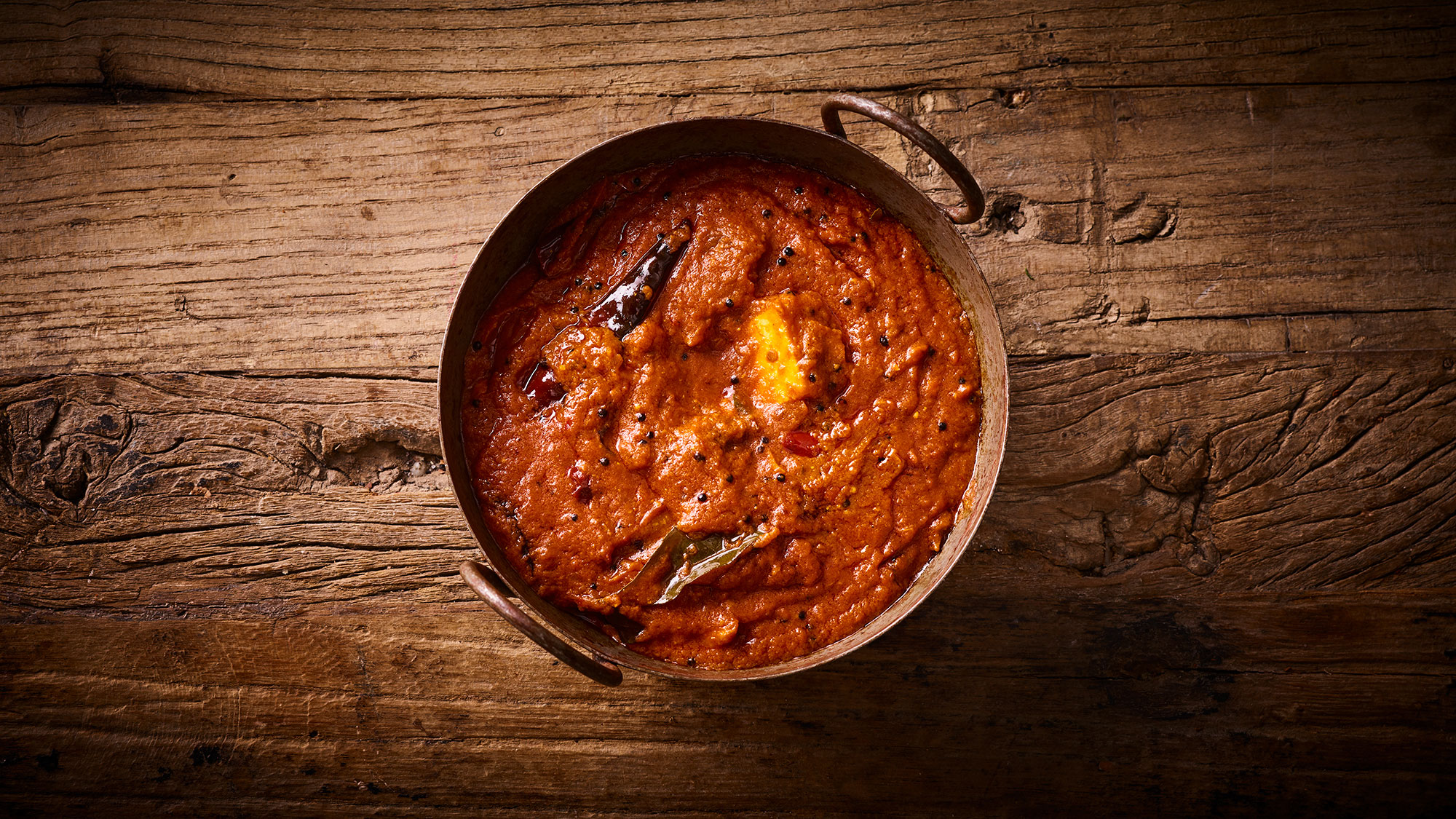
Bindia’s Paneer Madras is our head chef’s tribute to Southern India – and the healthiest thing on the menu.
Paneer Madras owes its name to its place of origin, namely the South Indian metropolis of Madras, today also known as Chennai. According to the legend, this dish received its name when English merchants visited the city in 1640.
In Southern India, you typically eat much more spicy food than in the North. That’s why the Paneer Madras is much hotter than our North Indian curries like our Korma and Butter Curry. As a matter of fact, the Madras curry is the strongest one in our menu.
In several South Indian states, there are many religious and spiritual communities and traditions that don’t eat meat. The most ‘restrictive’ spiritual diet is likely to be found within Jainism. This religion not only prohibits meat, fish, egg, and other animal products, but also root vegetables, which therefore excludes many otherwise common ingredients of the Indian kitchen like turmeric, ginger, garlic, and onion; the latter being a central pillar of the North Indian cuisine.
Even though it’s far from the majority that belongs to this religious minority, their ancient precepts have had a significant influence on many regional kitchens. No matter your religion or dietary habits, Indians consider vegetarian food appropriate for all occasions. That is why vegetarian restaurants are quite normal; and many of these are run by Jains.
Therefore, the South Indian kitchen focuses heavily on ingredients like tomato, coconut, tamarind, mustard seeds, mustard leaves, and, not least, curry leaves, which, despite their name, are not directly related to curry powder.
Curry leaves gives the food notes of lime, citrus, and basil, yet they are at least as known for their healing properties. These leaves are, among other things, rich in several vitamins as well as iron and calcium. That’s why they are used in Ayurvedic medicine in the treatment of a host of illnesses.
The curry tree is nicknamed “the sweet Neem”, referring to the neem tree, which has a very central and almost sacred role in Ayurveda. Everything from the leaves, seeds, fruits, flowers, roots, and bark of the neem tree is used in Ayurveda for the treatment of a host of illnesses.
As a consequence, this tree has in recent times become the focal point of modern medicine and more than 140 compounds have since been isolated from all parts of this amazing tree. While the neem tree holds an array of remedies, its leaves are generally considered too bitter for cooking. The leaves of the curry tree, on the other hand, are both applicable in cooking and preventive medicine – hence the name “Sweet Neem”.
“My mother’s father was an Ayurvedic doctor”, says Bindia’s founder and head chef Amer Suleman. “His treatments were always based on the customization of one’s diet.” The culinary philosophy of Bindia, therefore, rests on a profound respect and understanding of Ayurveda and the influence of food on one’s health and wellbeing.
”I’m very inspired by the South Indian kitchen and its vegetarian focus, and I have great respect for the culture and particularly ingredients like coconut, tomato, curry leaves, and tamarind”, says Amer Suleman. “The taste as well as the nutrition encapsulated in these ingredients and dishes is quite exciting. My Madras is a celebration of the South Indian kitchen and the healthiest thing we serve.”
The curry leaves play a big factor in both the taste of the Paneer Madras as well as its nutritional value. But so does the asafoetida, which is a spice extracted from the plant Ferula Asafoetida.
The asafoetida has a lot of healing properties, is rich in antioxidants, and is especially used in the aid of digestion. Asafoetida is also very common in dal dishes. Furthermore, asafoetida functions as a superb savory enhancer and is therefore an indispensable part of the temperings that our Paneer Madras undergoes.
Tempering is an Indian spicing method, in which grinded spices are stir-fried at burning hot temperatures. When the crushed spices hit the boiling warm fat, they have a heat shock response, which makes them discharge their essential oils and, thereby, rich flavor.
Together with whole curry leaves, we moreover use whole and fried chilis in our Paneer Madras, which provide a richer and rounder taste than mere chili powder as well as more substance.
While “Madras” refers to the curry, “Paneer” is the name of a popular fresh acid-set cheese created from cow or buffalo milk, which constitutes the main ingredient in Paneer Madras. Paneer is no longer just popular in its home country but has gradually gained quite some traction in the West as well. Being low in fat and high in protein, this fresh and filling cheese has increasingly become a sought-after source of protein in many meat-free dishes.
As Paneer has a mild taste and open structure, it easily absorbs the taste from the food and spices that it is cooked together with; in this case, spicy temperings including asafoetida and curry leaves in the hot, tomato based Madras.
Enjoy!
Try our Paneer Madras at your local Bindia in Østerbro, Nørrebro, Frederiksberg, Amager, Lyngby, and Søborg, or simply order it here.